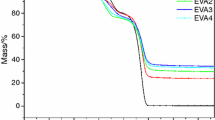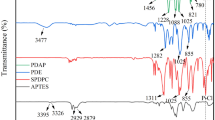Abstract
In this work, a novel single macromolecular intumescent flame retardant (DT-M) was prepared by self-assembly of diethylenetriamine penta-(methylenephosphonic) acid with melamine, and modified layered double hydroxides (LDH) were also prepared by intercalating phytic acid into LDHs. The chemical structures of DT-M and phytic acid intercalated LDHs (PA–LDH) were fully characterized by different analytical instruments, and then were introduced into PLA by melt compounding to prepare a flame retardant biodegradable PLA composite. The fire performance evaluation of PLA composites by limiting oxygen index (LOI), vertical burning (UL-94) and cone calorimeter tests indicated that the introduction of 14% DT-M and 1% PA–LDH increased the LOI value from 19.4 to 38.9%, upgraded the UL-94 rating from no rating to V-0, and decreased the peak heat release rate from 812 to 301 kW m−2. The analysis for decomposition products of PLA composite and the observation of morphology of the char suggested that DT-M and PA–LDH took effects in both condensed phase through promoting char formation and gas phase through releasing inert gases.




















Similar content being viewed by others
References
Zhao XM, Guerrero FR, Llorca J, Wang DY (2016) New superefficiently flame-retardant bioplastic poly(lactic acid): flammability, thermal decomposition behavior, and tensile properties. ACS Sustain Chem Eng 4:202–209
Jiang P, Gu XY, Zhang S, Zhao Q, Hu ZW (2015) Synthesis, characterization, and utilization of a novel phosphorus/nitrogen-containing flame retardant. Ind Eng Chem Res 54:2974–2982
Wen X, Gong J, Yu H, Liu Z, Wan D, Liu J, Tang T (2012) Catalyzing carbonization of poly(l-lactide) by nanosized carbon black combined with Ni2O3 for improving flame retardancy. J Mater Chem 22:19974–19980
Zhan J, Song L, Nie S, Hu Y (2009) Combustion properties and thermal degradation behavior of polylactide with an effective intumescent flame retardant. Polym Degrad Stab 94:291–296
Wang X, Hu Y, Song L, Xuan SY, Xing WY, Bai ZM, Lu HD (2010) Flame retardancy and thermal degradation of intumescent flame retardant poly(lactic acid)/starch biocomposites. Ind Eng Chem Res 50:713–720
Liao FH, Ju YQ, Dai X, Cao Y, Li JW, Wang XL (2015) A novel efficient polymeric flame retardant for poly (lactic acid) (PLA): synthesis and its effects on flame retardancy and crystallization of PLA. Polym Degrad Stab 120:251–261
Chen C, Gu XY, Jin XD, Sun J, Zhang S (2017) The effect of chitosan on the flammability and thermal stability of polylactic acid/ammonium polyphosphate biocomposites. Carbohydr Polym 157:1586–1593
Lin HJ, Liu SR, Han LJ, Wang XM, Bian YJ, Dong LS (2013) Effect of a phosphorus-containing oligomer on flame-retardant, rheological and mechanical properties of poly (lactic acid). Polym Degrad Stab 98:1389–1396
Zhao Q, An QF, Ji YL, Qian JW, Gao CJ (2011) Polyelectrolyte complex membranes for pervaporation, nanofiltration and fuel cell applications. J Membr Sci 379:19–45
Kim YS, Li YC, Pitts WM, Werre M, Davis RD (2014) Rapid growing clay coatings to reduce the fire threat of furniture. Acs Appl Mater Interface 6:2146–2152
Mateos AJ, Cain AA, Grunlan JC (2014) Large-scale continuous immersion system for layer-by-layer deposition of flame retardant and conductive nanocoatings on fabric. Ind Eng Chem Res 53:6409–6416
Laufer G, Kirkland C, Morgan AB, Grunlan JC (2012) Intumescent multilayer nanocoating, made with renewable polyelectrolytes, for flame-retardant cotton. Biomacromolecules 13:2843–2848
Zhang T, Yan HQ, Shen L, Fang ZP, Zhang JJ, Zhang BY (2014) Chitosan/phytic acid polyelectrolyte complex: a green and renewable intumescent flame retardant system for ethylene–vinyl acetate copolymer. Ind Eng Chem Res 53:19199–19207
Chen ZX, Su XX, Deng SP (2010) Molecular recognition of melamine by vesicles spontaneously formed from orotic acid derived bolaamphiphiles. J Phys Chem B 115:1798–1806
Wang Y, Liu JB, Tang SS, Dai ZQ, Jin RF (2016) Theoretical research on self-assembly system of molecularly imprinted polymers formed by melamine and trifluoromethacrylic acid. Struct Chem 27:897–905
Chng GYY, Sun X, Cho SJ, Rajwar D, Grimsdale AC, Fichou D (2014) Synthesis and 2D self-assembly at the liquid–solid interface of novel H-bonding linear π-conjugated oligomers terminated by uracil and melamine units. New J Chem 38:2407–2413
Kiaei Z, Haghtalab A (2014) Experimental study of using Ca-DTPMP nanoparticles in inhibition of CaCO3, scaling in a bulk water process. Desalination 338:84–92
Nyambo C, Songtipya P, Manias E, Jimenezgasco MM, Wilkie CA (2008) Effect of MgAl-layered double hydroxide exchanged with linear alkyl carboxylates on fire-retardancy of PMMA and PS. J Mater Chem 18:4827–4838
Liu XS, Gu XY, Zhang S, Jiang Y, Sun J, Dong MZ (2013) Effects of dihydrogen phosphate intercalated layered double hydroxides on the crystal behaviors and flammability of polypropylene. J Appl Polym Sci 130:3645–3651
Zhang S, Liu XS, Gu XY, Jiang P, Sun J (2015) Flammability and thermal behavior of polypropylene composites containing dihydrogen phosphate anion-intercalated layered double hydroxides. Polym Compos 36:2230–2237
Jiang Y, Gu XY, Zhang S, Tang WF, Zhao JR (2015) The preparation and characterization of sulfamic acid-intercalated layered double hydroxide. Mater Lett 150:31–34
Shan XY, Song L, Xing WY, Hu Y, Lo SM (2012) Effect of nickel-containing layered double hydroxides and cyclophosphazene compound on the thermal stability and flame retardancy of poly(lactic acid). Ind Eng Chem Res 51:13037–13045
Huang ST, Wang GL, Li NB, Luo HQ (2012) Mechanism of the pH-induced aggregation reaction between melamine and phosphate. RSC Adv 2:10948–10954
Venkatraman R, Ray PC, Chan SC (2004) Self-assembly structure of the levulinic acid–melamine lattice. Int J Quantum Chem 100:758–763
Doğan M, Bayramlı E (2011) Synergistic effect of boron containing substances on flame retardancy and thermal stability of clay containing intumescent polypropylene nanoclay composites. Polym Adv Technol 22:1628–1632
Feng C, Zhang Y, Liu S, Xu J (2012) Synergistic effect of La2O3, on the flame retardant properties and the degradation mechanism of a novel PP/IFR system. Polym Degrad Stab 97:707–714
Zhang JH, Juan SD, Esteban-Cubillo A, Santaren J, Wang DY (2015) Effect of organo-modified nanosepiolite on fire behaviors and mechanical performance of polypropylene composites. Chin J Chem 33:285–291
Sun J, Gu XY, Zhang S, Coquelle M, Bourbigot S, Duquesne S, Casetta M (2014) Improving the flame retardancy of polyamide 6 by incorporating hexachlorocyclotriphosphazene modified MWNT. Polym Adv Technol 25:1099–1107
Tang G, Wang X, Xing WY, Zhang P, Wang BB, Hong NN, Yang W, Hu Y, Song L (2012) Thermal degradation and flame retardance of biobased polylactide composites based on aluminum hypophosphite. Ind Eng Chem Res 51:12009–12016
Shao ZB, Deng C, Tan Y, Yu L, Chen MJ, Chen L, Wang YZ (2014) Ammonium polyphosphate chemically-modified with ethanolamine as an efficient intumescent flame retardant for polypropylene. J Mater Chem A 2:13955–13965
Tang WF, Zhang S, Sun J, Gu XY (2016) The flame retardancy and thermal stability of polypropylene composite containing ammonium sulfamate intercalated kaolinite. Ind Eng Chem Res 55:7669–7678
Gao Y, Wu J, Wang Q, Wilkie C, O’Hare D (2014) Flame retardant polymer/layered double hydroxide nanocomposites. J Mater Chem A 2:10996–11016
Bourbigot S, Bras ML, Duquesne S, Rochery M (2004) Recent advances for intumescent polymers. Macromol Mater Eng 289:499–511
Alongi J, Han ZD, Bourbigot S (2015) Intumescence: tradition versus novelty. A comprehensive review. Prog Polym Sci 51:28–73
Acknowledgments
This work was financially supported by National Natural Science Foundation of China (Grant No. 21674008) and Beijing Natural Science Foundation (Grant No. 2174083).
Author information
Authors and Affiliations
Corresponding authors
Rights and permissions
About this article
Cite this article
Jin, X., Gu, X., Chen, C. et al. The fire performance of polylactic acid containing a novel intumescent flame retardant and intercalated layered double hydroxides. J Mater Sci 52, 12235–12250 (2017). https://doi.org/10.1007/s10853-017-1354-5
Received:
Accepted:
Published:
Issue Date:
DOI: https://doi.org/10.1007/s10853-017-1354-5




